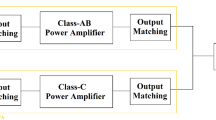Abstract
In this paper, a design method of a compact, low-cost and high-efficiency microwave power amplifier for using in the 5G wireless communication applications is presented. The proposed approach is based on a combination of harmonically tuned technique to improve the efficiency and careful design of the input and output matching networks to simplify structures and miniaturize the power amplifier. The amplifier aims at operating at 5.8 GHz band using a low-cost 5 W GaN HEMT device from Qorvo. The output matching network is designed to terminate up to the third harmonic while the input matching network is designed to terminate up to the second harmonic. Both small-signal and large-signal performances of the proposed amplifier are evaluated by simulation and experiment. The simulated and measured results show that the designed power amplifier offers a compact size. The best measured input and output return losses are -9.4 dB at 6 GHz and -15.3 dB at 6.1 GHz, respectively and the best power gain is 12.9 dB at 5.7 GHz. The measured efficiency, output power and power gain at 5.72 GHz are 41.7 \(\%\), 37 dBm (5 W) and 10.5 dB, respectively.















Similar content being viewed by others
References
Lie DYC et al (2018) A review of 5G power amplifier design at cm-wave and mm-wave frequencies. Wireless Communications and Mobile Computing, vol 2018, Article ID 6793814, 16
Ali SN et al (2018) A 40% PAE frequency-reconfigurable CMOS power amplifier with tunable gate-drain neutralization for 28-GHz 5G radios. IEEE Transactions on Microwave Theory and Techniques 66(5):2231–2245
Drews S et al (2017) A 10-W S-band power amplifier for future 5G communication. In: 2017 47th European microwave conference (EuMC). Nuremberg, Germany, pp 10–12
Asbeck PM et al (2016) Power amplifiers for mm-wave 5G applications: technology comparisons and CMOS-SOI demonstration circuits. IEEE Transactions on Microwave Theory and Techniques 68(5):1620–22
Neininger P et al (2017) A sequential power amplifier at 3.5 GHz for 5G applications. In: 2017 47th European microwave conference (EuMC), pp 284–287
Buzzi S et al (2016) A survey of energy-efficient techniques for 5G networks and challenges ahead. IEEE Journal on Selected Areas in Communications 34(4):697–709
Nguyen LD (2018) Resource allocation for energy efficiency in 5G wireless networks. EAI Endorsed Trans Ind Netw Intell Syst 5(14)
Tran Q-N et al (2021) D2D Multi-hop multi-path communications in B5G networks: a survey on models, techniques, and applications. EAI Endorsed Trans Ind Netw Intell Syst 7(25)
Kitazawa S et al (2012) Energy harvesting from ambient RF sources. In: 2012 IEEE MTT-S international microwave workshop series on innovative wireless power transmission: technologies, systems, and applications, pp 39–42
Shi Y et al (2018) Design of a novel compact and efficient rectenna for wifi energy harvesting. Progress In Electromagnetics Research C 83:57–70
Sogorb T et al (2008) Studying the feasibility of energyharvesting frombroadcast RF station for WSN. In Proceedings of the IEEE instrumentation and measurement technology conference proceedings (IMTC ’08), pp 1360–1363, Victoria, Canada
Deepa SN et al (2017) RF energy harvesting using 900MHz of mobile signal frequency to charging the mobile battery, In: 2017 International conference on innovations in green energy and healthcare technologies (IGEHT), Coimbatore, India
Sokal N et al (1975) Class E- A new class of high-efficiency tuned single ended switching power amplifiers. IEEE J. Solid-State Circuits SC–10:168–176
Grebennikov A (2016) High-efficiency class-e power amplifier with shunt capacitance and shunt filter. IEEE Transactions on Circuits and Systems I: Regular Papers 63(1):12–22
Colantonio P et al (1999) On the class-F power amplifier design. International Journal of RF and Microwave Computer-Aided Engineerin
Jin XX et al (2017) High-efficiency filter-integrated class-F power amplifier based on dielectric resonator. IEEE Microwave and Wireless Components Letters 27(9):827–829
Kamiyama M et al (2012) 5.65 GHz high-efficiency GaN HEMT power amplifier with harmonics treatment up to fourth order. IEEE Microw Wireless Compon Lett 22(6):315–317
Yao T et al (2013) Frequency characteristic of power efficiency for 10 W/30 W-class 2 GHz band GaN HEMT amplifiers with harmonic reactive terminations. In: Proc. Asia-Pacific Microw Conf, pp 745–747
Enomoto J et al (2017) Second harmonic treatment technique for bandwidth enhancement of GaN HEMT amplifier with harmonic reactive terminations. IEEE Trans Microw Theory Techn 65(12):1–6
Sengar BS et al (2021) GaN-based technology for 5G applications. In: Singh S, Arya R, Singh MP, Iyer B (eds) CMOS analog IC design for 5G and beyond. Lecture Notes in Electrical Engineering, vol 719. Springer, Singapore
Wang K, Sheng C (2020) Application of GaN in 5G technology. J Phys Conf Ser 1699:012004
Inoue A (2021) Millimeter-wave GaN devices for 5G: massive MIMO antenna arrays for Sub-6-Ghz and mm-wave bandwidth. IEEE Microwave Magazine 22(5):100–110
Li T et al (2019) Millimeter-wave continuous-mode power amplifier for 5G MIMO applications. IEEE Transactions on Microwave Theory and Techniques 67(7):3088–3098
Chen W et al (2017) Energy-efficient doherty power amplifier MMIC and beamforming-oriented digital predistortion for 5G massive MIMO application. In: 2017 IEEE asia pacific microwave conference (APMC), pp 391–394
Qin C et al (2017) A 5.8 GHz class-AB power amplifier with 25.4 dBm saturation power and 29.7% PAE. Sci China Inf Sci 60:042403
Gruner D et al (2008) Fully integrated 5.8 GHz sige power amplifier. In: 2008 38th European microwave conference, pp 301–304
Park Y et al (2017) A highly efficient power amplifier at 5.8 ghz using independent harmonic control. IEEE Microwave and Wireless Components Letters 27(1):76–78
URL: https://www.qorvo.com/ [Accessed Jun. \(2^\text{nd}\), 2021]
URL: https://www.keysight.com/zz/en/products/software/pathwave-design-software/pathwave-advanced-design-system.html [Accessed Jun. \(2^\text{ nd }\), 2021]
URL: https://www.modelithics.com/Home/ [Accessed Jun. \(2^\text{ nd }\), 2021]
Acknowledgements
This research is funded by Vietnam National Foundation for Science and Technology Development (NAFOSTED) under grant number 102.04-2018.14.
Author information
Authors and Affiliations
Corresponding author
Additional information
This paper has been accepted for publication in part in the 7th EAI International Conference on Industrial Networks and Intelligent Systems (INISCOM 2021)
Rights and permissions
About this article
Cite this article
Manh, L.D., Hoang, VP. & Tran, X.N. A Cost-Effective 5-W GaN HEMT Power Amplifier for Sub-6-GHz 5G Wireless Communications. Mobile Netw Appl 27, 1757–1767 (2022). https://doi.org/10.1007/s11036-022-01926-6
Accepted:
Published:
Issue Date:
DOI: https://doi.org/10.1007/s11036-022-01926-6




